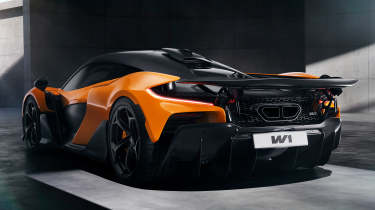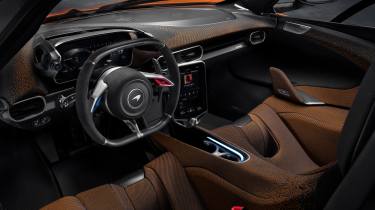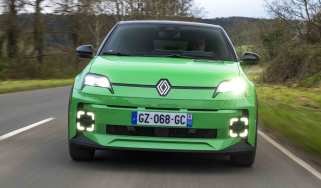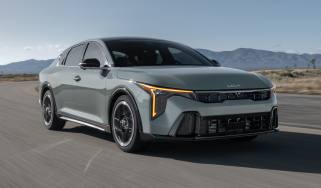New McLaren W1 is a landmark £2m hybrid hypercar with 1,258bhp
The successor to the McLaren F1 and P1 gets a 1,258bhp hybrid V8, plus active aero capable of creating up to 1,000kg of downforce
This is the new McLaren W1; the third in the British company’s line of flagship ‘1’ cars and a successor to the legendary F1 and P1 models. Headline stats include a 1,258bhp twin-turbo 4.0-litre V8 hybrid powertrain capable of 0-62mph in 2.7 seconds and an electronically-limited top speed of 217mph.
The breathtaking numbers don’t stop there, either. It’ll do 0-124mph in 5.8 seconds and 0-186mph in “less than” 12.7 seconds. That makes it faster than a McLaren Speedtail in a straight line, and three seconds quicker than a Senna around the firm’s reference circuit at the Nardo test facility in Italy. It’ll stop from 124mph in just 100 metres.
In isolation, the “power-dense E-module” develops 342bhp, but combined with the new 915bhp V8, the W1 produces more power than any McLaren road car that came before it. It also has the highest specific output (230bhp per litre), and the highest power-to-weight ratio (899bhp/tonne) of any McLaren. The W1 tips the scales at 1,399kg (dry), and measures 4,635mm nose to tail – 47mm longer than a P1.
Many of those performance figures come courtesy of the new model’s “Formula One-inspired ground-effect aerodynamics” – including a ride height that can drop by up to 37mm and an Active Long Tail rear wing that extends rearwards by 300mm. The result is up to 1,000kg of downforce at 174mph.
McLaren says the W1 is “determined by real supercar attributes”. Bosses claim the car offers “performance everywhere”, with the model elevating the ‘1’ car lineage to “new heights in every aspect of performance”.
As well as that carbon construction, the W1 boasts carbon-ceramic racing brakes and a suspension system consisting of inboard springs and dampers with 3D-printed uprights and wishbones. The steering is an electro-hydraulic power-assisted system that the maker says offers “ultimate precision”. The W1 sits on a set of ultra-lightweight magnesium wheels wrapped in unique Pirelli P-Zero Trofeo RS tyres.
Technically, the McLaren W1 is a plug-in hybrid, although we’re told this is merely for battery conditioning, with the car’s Type 2 socket situated behind a panel on the nose and not easily accessible for public or home charging. The 1.4kWh battery offers no meaningful electric range (1.6 miles, officially), but does allow for quiet starts and silent manoeuvring. The eight-speed DCT transmission features an electric reverse gear.
The new model has been revealed to coincide with the 50th anniversary of McLaren’s first F1 title in 1974, when Emerson Fittipaldi lifted the trophy to become the youngest world champion to that point. McLaren has since won 12 drivers’ and eight constructors’ titles in total.
Based around a bespoke McLaren Aerocell carbon-fibre monocoque, the W1’s styling is an evolution of previous models’ – albeit with a sharper edge that is unashamedly optimised for aerodynamics following 350 hours in the wind tunnel. Anhedral doors open up and out to reveal a completely new cabin, with the fixed seats integrated into the car’s tub. As such, the pedals, steering wheel and primary controls move to fit the driver, offering what McLaren calls “the purest connection to the car”.
McLaren claims “virtually unlimited bespoke options” are available via the brand’s MSO programme, including a new tailored, lightweight InnoKnit interior material that is “knitted to fit” – almost completely eliminating waste and off-cuts. It’s available in multiple colours, and can even be incorporated into the speaker grilles of the car’s Bowers & Wilkins stereo. The MSO programme extends to the exterior, too, with single and two-tone finishes available.
There’s no rear window, and as such, the W1 uses a digital mirror fed via a camera situated below the car’s shark-fin antenna. A benefit of this layout means the W1 boasts 117 litres of storage space behind the front seats; the headrests fold to reveal enough room for “two weekend bags or two crash helmets.” Despite the lack of glass, McLaren claims the W1 offers “great visibility” – thanks in part to the firm’s thinnest ever A-pillars.
Alongside those fixed seats, the W1 features a new flat-bottom steering wheel with a pair of buttons – a first for the brand. These switches control the car’s ‘Boost’ and ‘Drag Reduction’ (DRS) functions – the latter via that active rear wing.
A set of digital dials complements the W1’s eight-inch central screen running McLaren Infotainment System (MIS) II with integrated Apple CarPlay and USB-C connectivity. The car’s drive modes are operated via rocker switches, while other buttons – such as those for the gear selection and race mode – are situated overhead.
The McLaren W1 is priced from “circa £2 million” including taxes in the UK. A total of 399 cars will be built, and all customer cars are already accounted for.
Is the McLaren W1 a worthy successor to the F1 and P1? Let us know your thoughts in the comments section...









